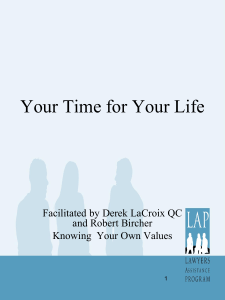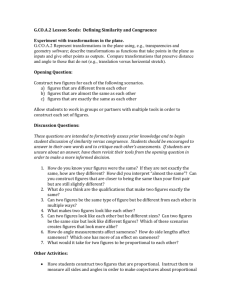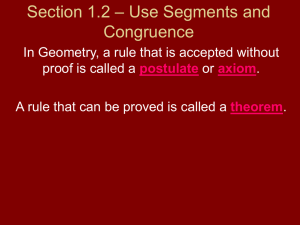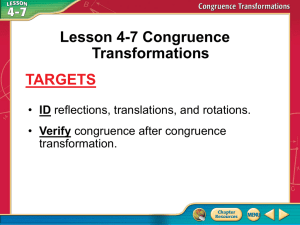Lemma 2
advertisement
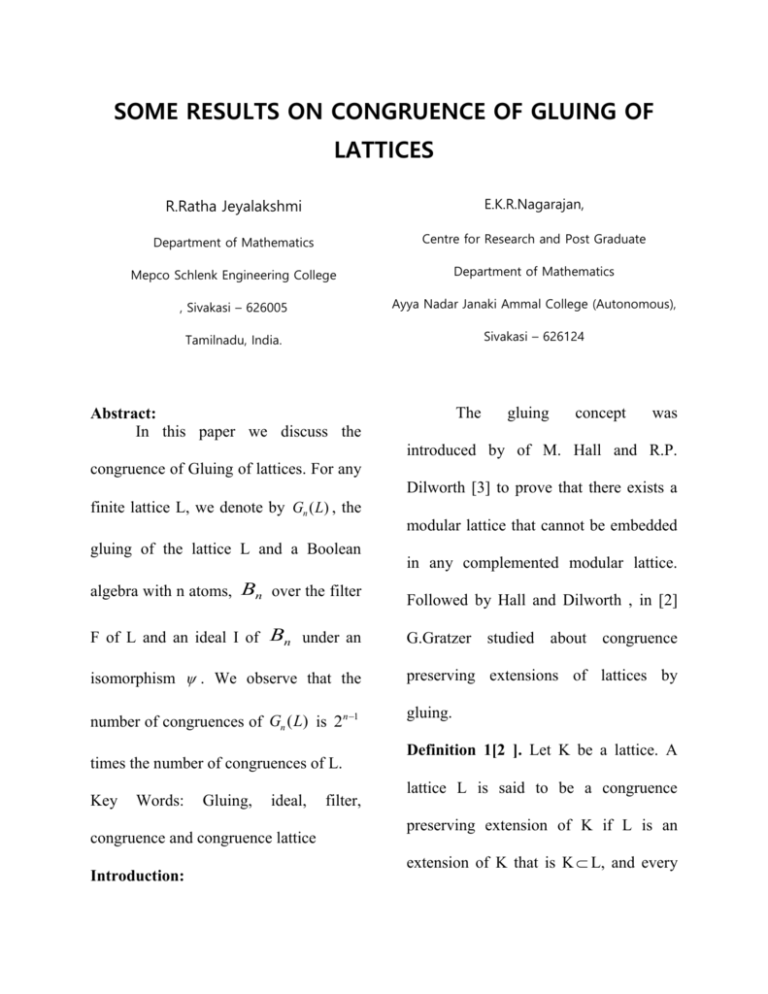
SOME RESULTS ON CONGRUENCE OF GLUING OF
LATTICES
R.Ratha Jeyalakshmi
E.K.R.Nagarajan,
Department of Mathematics
Centre for Research and Post Graduate
Mepco Schlenk Engineering College
Department of Mathematics
, Sivakasi – 626005
Ayya Nadar Janaki Ammal College (Autonomous),
Tamilnadu, India.
Sivakasi – 626124
The
Abstract:
In this paper we discuss the
gluing
concept
was
introduced by of M. Hall and R.P.
congruence of Gluing of lattices. For any
Dilworth [3] to prove that there exists a
finite lattice L, we denote by Gn ( L) , the
modular lattice that cannot be embedded
gluing of the lattice L and a Boolean
in any complemented modular lattice.
algebra with n atoms, Bn over the filter
Followed by Hall and Dilworth , in [2]
F of L and an ideal I of Bn under an
G.Gratzer studied about congruence
isomorphism . We observe that the
preserving extensions of lattices by
number of congruences of Gn ( L) is 2n1
gluing.
times the number of congruences of L.
Key
Words:
Gluing,
ideal,
congruence and congruence lattice
Introduction:
filter,
Definition 1[2 ]. Let K be a lattice. A
lattice L is said to be a congruence
preserving extension of K if L is an
extension of K that is K L, and every
congruence of K has exactly one
and dually for the meet. If L has a zero,
extension of L satisfying K .
0 L , then the last clause for the join may
Definition 2 [ 2]. Let K and L be lattices.
be
Let F be filter of K and let I be an ideal
a G b (a K 0 L ) L b if a K and b L
. G contains K and L as sublattices.
of L. If F is isomorphic to I with as
rephrased:
Infact, K is an ideal and L is a filter of G.
the isomorphism, then we can form the
Lemma 4 [ 2]. Let K, L, F, I and G be
gluing of K and L over F and I with
respect to defined as follows.
given as above. Let A be a lattice
containing K and L as sublattices such
We form the disjoint union K L and
identify a F with a I for all a F, to
that K L I F . Then K L is a
sublattice of A and it is isomorphic to G.
Lemma 5 [2]. A congruence of G can
obtain the set G. We order G as follows:
be uniquely written in the form
ab
K L , where K is a congruence of K
r
ifand
only
if,
and L is a congruence of L satisfying
a K b if a, b K
the condition that K restricted to F
a L b if a, b L
a x and (x) b if a K and b L for some x F
equals L restricted to I (under the
L
K
.
identification
of
elements
by
).
Lemma 3[2]. Let K, L, F, I and G be
Conversely, if K is a congruence of K
given as above. Then G is a lattice. The
and L is a congruence of L satisfying
join in G is described by a G b=
a K b if a, b K
a b if a, b L
L
(a K x) L b if a K ,b L
for any x F and x b
the condition that K restricted to F
equals L restricted to I, then
r
K L is a congruence of G.
Lemma 6 [2]. If K and L are modular
reflexive product K L is defined as
(distributive), so is gluing G of K and L.
K L ( K L ) .
Lemma 7 [2]. If K and L are finite semi
Definition 11 [2]. Let K and L be any
modular lattices, then so is the gluing G
two lattices and K L . Then every
of K and L.
congruence of L reflects (or restricts)
Lemma 8 [2]. Let K and L be lattices, let
to K: the relation K 2 K on K is
F be a filter of K and let I be an ideal of
a congruence of K. So, we get the
L. Let be an isomorphism between F
reflection map (also called restriction
and I, let G be the gluing of K and L over
map) re: Con(L) Con(K) that maps a
F and I with respect to . If L is a
congruence of L to K .
congruence preserving extension of I,
Construction of Gluing of Lattices:
then G is a congruence preserving
extension of K.
r
Consider a finite Boolean algebra
with n atoms. Glue the lattices Bn and
Corollary 9 [2]. Let K, L, F, I and be
Bn with an ideal I of Bn isomorphic to
given as above. If I and L are simple
C2 and the filter F of
lattices,
then
G
is
a
Bn isomorphic to C2
congruence
preserving extension of K. The map
is an isomorphism between Con(K)
under the isomorphism
, denote by G.
The lattice G is distributive as
Bn is
distributive.
and Con(L).
Lemma 1: Gluing of two Boolean algebra
Definition 10 [2]. Let K and L be any
two lattices. If K is a binary relation on
K and L is a binary relation on L, the
with two atom (2) is isomorphic to the direct
product of C2 and C3 .
Lemma 2: Gluing of Boolean algebra
Then by lemma 2, G is isomorphic to
with two atom n times is isomorphic to
Cn 1 C2 .
direct product of C2 and Cn1 .
Now, Con(G) Con Cn1 C2
Proposition 3: Gluing of Boolean
Con(Cn1 ) Con(C2 )
algebra B2 n times is a congruence
Bn C2 Bn1 .
preserving extension of a chain with n+2
elements.
Also, G Cn 2 and Con (Cn 2 ) Bn1 .
Proof. Let G be the gluing of Boolean
Therefore, Con(G) Con(Cn 2 ) .
algebras with two atoms ( B2 ) n times
Hence the gluing of a Boolean algebra,
over the filter F and an ideal I of B2
B2 n times is a distributive congruence
isomorphic to C2 as shown in figure 1.
preserving extension of a chain with n+2
elements.
Figure1
Definition 5: For any finite lattice L, we
denote by Gn ( L) , the gluing of the lattice
L and a Boolean algebra with n atoms,
Theorem 4. Let G be the gluing of two
Bn over the filter F of L and an ideal of
simple lattices A and B over the filter F
I under an isomorphism such that both
of A and an ideal I of B under an
F and I are isomorphic to
isomorphism. If I and F are simple
C2 . The
operations join and meet are defined as
lattices, then G is simple.
in definition 2 [2] and lemma 3 [2].
Proof. Let A and B be simple lattices.
C3 with a
We know that, if L is simple, then
Example 6. Consider a chain
Con(L) is isomorphic to C2 . Here
filter F isomorphic to C2 and a Boolean
Con(A) Con( B ) C2 . We have by
algebra with two atoms B2 having an
Lemma 5 [2] every congruence of G is
ideal I isomorphic to F. Glue the lattices
uniquely determined by A r B . But
B2 over the filter F of L and an
L and
the congruences in both A and B are
ideal I of B2 . The lattices L, B2 and
trivial congruences. So, their reflexive
G2 (C3 ) are shown in figure 2.
products are also trivial. Therefore G has
only trivial congruences. Hence G is
simple.
b
1
F
a
1
c
b
b
c
I
a
a
C3
B2
G2 (C3 )
Figure 2
The congruence lattice of C3 is
Con( C3 ) = { ,1 , 2 , }, where - the
null
congruence,
1 ={(0),(a,1)},
2
={(0),(a,c),(b,1)}
3 ={(0)(a,b)(c,1)};
4 ={(0ab)(c1)};
5 ={(0ac)(b1)};
6 {(0)(abc1)} and
-
all congruence.
={(0,a),(1)} and - all congruence.
Therefore it is isomorphic to B3 . Hence
Therefore it is isomorphic to B2 . The
Con(G2 (C3 )) 2 Con(C3 ) .
congruence lattice of B2 is
Con( B2 ) = { ,1 , 2 , }where -the null
Example 7: Consider a semi modular
lattice L= N 6 with a filter F isomorphic
2
to C2 and a Boolean algebra with two
={(a,c),(b,1)} and -all congruence.
atoms B2 having an ideal I isomorphic to
1 ={(a,b),(c,1)},
congruence,
Therefore it is isomorphic to B2 .
congruence
lattice
of
The
Glue the lattices L and B2 over the filter
G2 (C3 ) ={
,1 ,2 ,3 ,4 ,5 ,6 , } where
F.
-the
null congruence, 1 ={(0,a),(b),(c,1)},
2
F of L and an ideal I of B2 . The lattices
L, B2 , G2 ( N6 ) and Con( G2 ( N6 ) ) are
shown in figure 3
e
1
d
a
e
b
c
f
B2
N6
1
e
f
3
4
d
1
c
b
2
a
0
Con(G2 ( N6 ))
G2 ( N6 )
Figure 3
The congruence lattice of N 6 is
The congruence lattice of B2 is
Con( N 6 ) = { , , }, where - the null
Con( B2 ) = { ,1 , 2 , }where -the null
congruence, ={(0,a,b,d),(c,e)} and -
congruence,
all
={(a,c),(b,1)} and -all congruence.
congruence.
isomorphic to C3 .
Therefore
it
is
1 ={(a,b),(c,1)},
Therefore it is isomorphic to B2 .
2
The congruence lattice of G2 ( N6 )
={ ,1 , 2 ,3 , 4 , } where -the null
congruence, 1 ={(0,a,b,d), (c,e), (f),(1)},
2 ={(0),(a),(c),(b),(d,f),(e,1)}
3 ={(0,a,b,d,f),(c,e,1)};
={(0abcde),(f1)};
-
isomorphism .
Let
L
be
a
L F is
congruence of L. Then
either equal to {(0)(a)} or {(0a)}. If
L F is equal to 2n1 congruences
4
all congruence.
of the gluing of Bn restricted to I. By
Lemma
1.66,
L
r
Bn is
a
Therefore it is isomorphic to the lattice
congruence
of
given in figure 2.
Hence
Gn ( L) .
Therefore
corresponding to each L , there are
Con(G2 ( N6 )) 2 Con( N6 ) .
2n1 Bn such that L F Bn I
Theorem 8. Let L be any lattice with
and L
a prime filter F. Then the number of
congruences of Gn ( L) is 2n1 times the
number of congruences of L.
Proof. Let L be any finite lattice with
r
Bn is a congruence of
Gn ( L) .
Hence
Con(Gn ( L)) 2n1 Con( L) .
Conclusion: In this paper we observed
and proved that the congruence of gluing
a prime filter F and Bn be a Boolean
of any lattice L with Boolean algebra
algebra with n atoms. Let I=(a] be a
with two atoms is isomorphic to two
prime ideal of Bn and F be a filter of
times the congruence lattice of L. Also
L which is isomorphic to I under an
we proved that the
congruences of
Gn ( L) is 2n1 times the number of
congruences of L. Further we study the
isomorphism between the congruence of
gluing of any two lattices and gluing of
their congruence lattices.
References:
[1 ]
G. Gr¨atzer, General Lattice Theory, second edition, new appendices by the author
with B. A. Davey, R. Freese, B. Ganter, M. Greferath, P. Jipsen, H. A. Priestley,
H. Rose, E. T.Schmidt, S. E. Schmidt, F. Wehrung, and R. Wille. Birkh¨auser
Verlag, Basel, 1998. xx+663 pp. ISBN: 0-12-295750-4, ISBN: 3-7643- 52396.Softcover edition, Birkh¨auser Verlag, Basel–Boston–Berlin, 2003. ISBN: 37643- 6996-5.
[2] G. Gratzer, The Congruences of a finite lattice”, A proof-by-picture approach,
Birkhauuser Boston, 2006.
[3] M. Hall and R.P Dilworth, the embedding problem for modular lattices, Annals
Math., 45(1944) 450-456.
[4]
G. Gr¨atzer and F. Wehrung, Proper congruence-preserving extensions of lattices,
Acta Math. Hungar. 85 (1999), 175–185.
